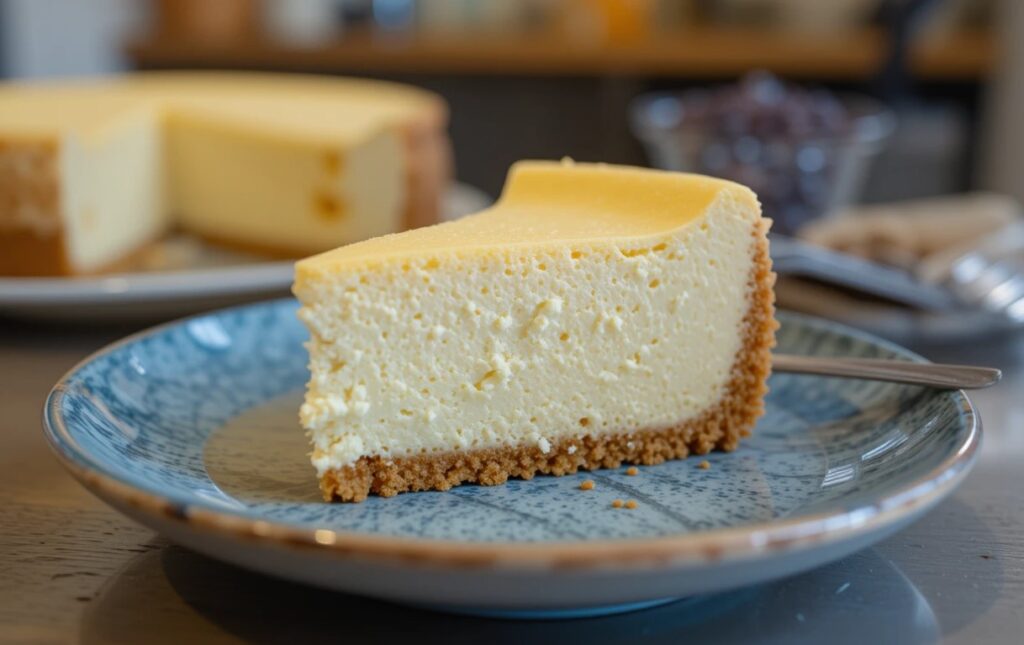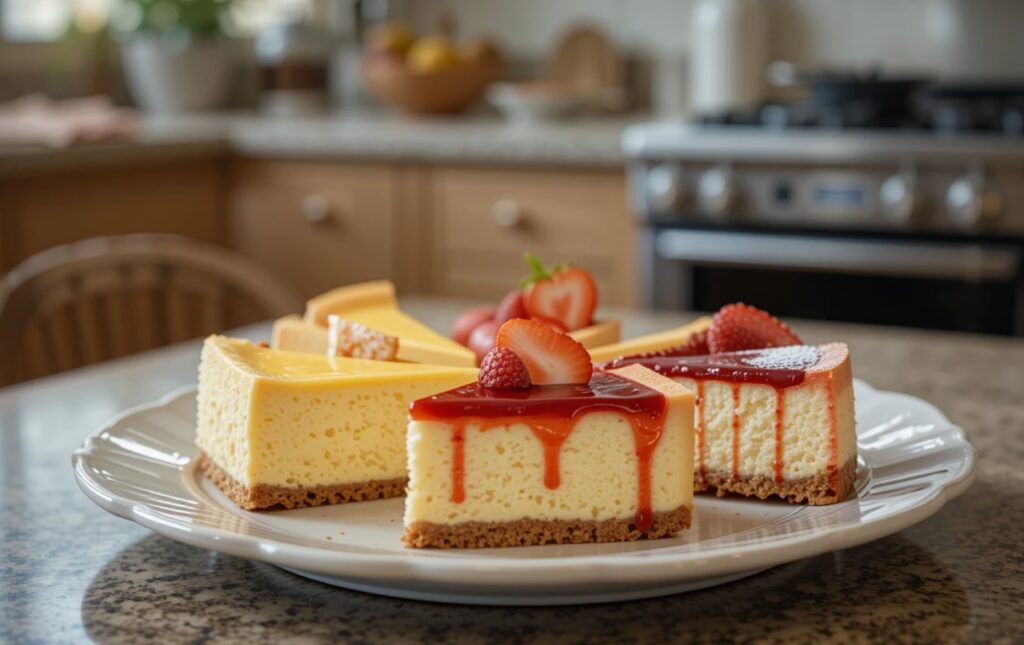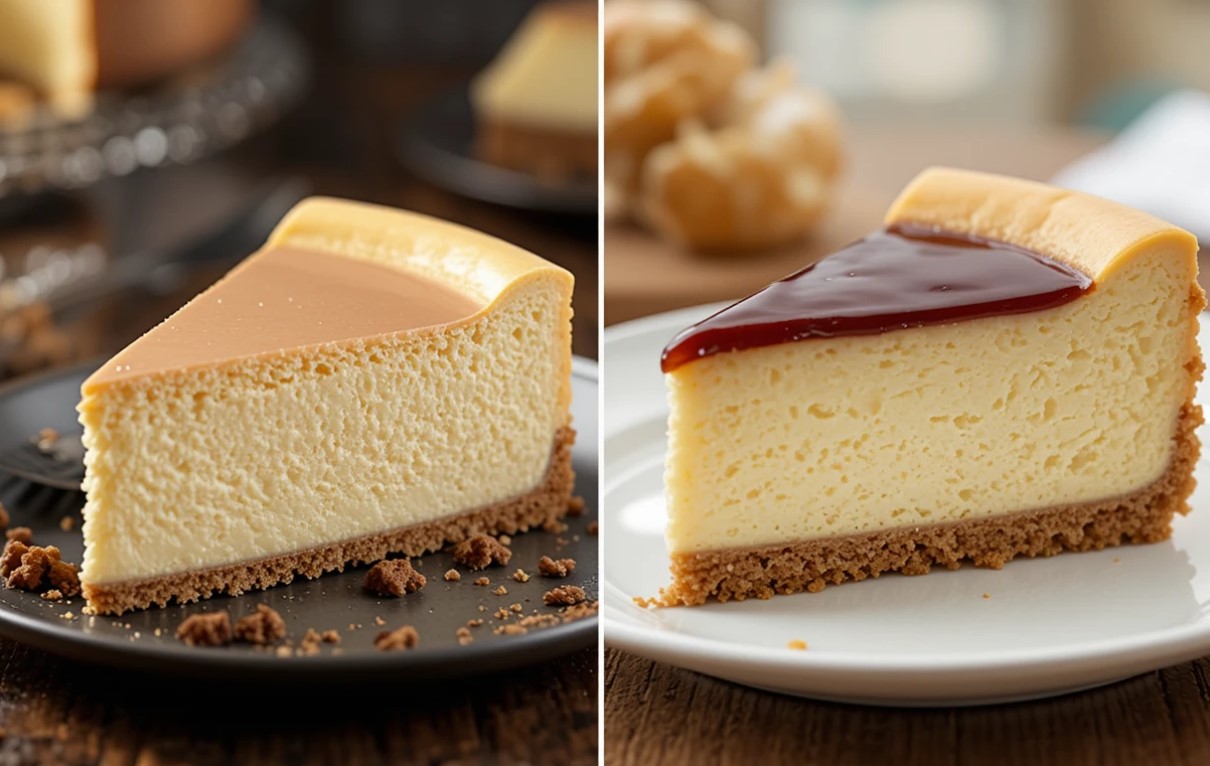Cheesecake is one of the most beloved desserts worldwide, offering a delightful balance of creamy richness and subtle sweetness. While this classic treat has many variations, New York cheesecake and classic cheesecake are two standout types that often spark debates among dessert enthusiasts. What sets these two iconic cheesecakes apart? From their ingredients to their textures and baking methods, let’s explore the unique qualities that define each type.
What is the difference between New York cheesecake and classic cheesecake?
Understanding Cheesecake Basics
Cheesecake has been a popular dessert for centuries, evolving with different cultures and culinary preferences. Before diving into the specific differences between New York and classic cheesecakes, it’s essential to understand the basics of this dessert.
What Makes Cheesecake a Cheesecake?
At its core, cheesecake consists of a creamy filling made primarily from cream cheese, eggs, sugar, and a crumbly base—usually a graham cracker or cookie crust. This dessert is cherished for its versatility, accommodating countless flavors and toppings to suit any palate. Despite the variations, the defining characteristic of cheesecake is its smooth, custard-like texture and rich taste.
Cheesecakes can be baked or no-bake, with the former being the more traditional method. Baking incorporates eggs into the mixture, which gives the cheesecake its firm structure and velvety finish. While these elements form the foundation, regional adaptations have added distinct twists, leading to unique styles like New York and classic cheesecake.
What is New York Cheesecake?
New York cheesecake is a legendary dessert known for its rich and indulgent qualities. Originating in the bustling heart of New York City, this style has become a hallmark of American desserts, celebrated for its decadence and unmistakable taste.
1 Ingredients of New York Cheesecake
The ingredients of New York cheesecake are what set it apart from other variations. The key components include:
- Cream Cheese: The star ingredient, used in generous quantities, gives the cheesecake its signature dense and creamy texture.
- Heavy Cream or Sour Cream: Adds to the richness, creating a luscious mouthfeel.
- Eggs: Provide structure while contributing to the custard-like texture.
- Sugar: Balances the tangy flavor of the cream cheese with sweetness.
- Vanilla Extract: Enhances the overall flavor profile.
Unlike many other cheesecakes, New York cheesecake avoids additives like gelatin or cornstarch, relying purely on the quality and balance of its ingredients for its iconic texture.
2 Texture and Flavor Profile of New York Cheesecake
New York cheesecake is known for its dense, smooth, and velvety texture. When you take a bite, it feels luxurious and indulgent, melting in your mouth with a rich creaminess that’s hard to replicate.
Flavor Profile: The flavor is robust and tangy due to the high proportion of cream cheese. While sweet, it avoids being overly sugary, allowing the tanginess of the cream cheese to shine. Some variations include a subtle hint of lemon to enhance its brightness.
Baking Method: A critical aspect of New York cheesecake is its baking technique. It’s typically baked at a high temperature initially to create a slight caramelization on top, then finished at a lower temperature to cook the interior gently. This results in the iconic, smooth consistency without cracks on the surface.
New York cheesecake stands out for its bold and indulgent nature, making it a favorite among dessert lovers who crave a rich and satisfying treat.
What is Classic Cheesecake?

While New York cheesecake has a bold and indulgent presence, classic cheesecake represents a more traditional and versatile take on this beloved dessert. Its lighter texture and more adaptable flavor make it a favorite for those who prefer a subtler approach to cheesecake.
1 Ingredients of Classic Cheesecake
Classic cheesecake recipes often vary depending on regional preferences and family traditions. However, the following ingredients are typically found in most versions:
- Cream Cheese: A primary ingredient, but often in smaller quantities compared to New York cheesecake. Sometimes, cream cheese is partially replaced with other dairy products.
- Sour Cream or Ricotta Cheese: Adds a lighter, airier texture and a mild tangy flavor. Ricotta is especially popular in European-style classic cheesecakes.
- Eggs: Provide structure, but the ratio is often lower than in New York cheesecake recipes.
- Sugar: Sweetens the mixture, but in a more understated way.
- Flour or Cornstarch: Used in many recipes to stabilize the filling, resulting in a slightly firmer consistency.
- Flavoring Agents: Vanilla extract is common, and some recipes incorporate zests or extracts for added flavor dimensions.
This combination of ingredients allows classic cheesecake to be more versatile, accommodating a wide variety of toppings and infusions.
2 Texture and Flavor Profile of Classic Cheesecake
The texture of classic cheesecake is noticeably lighter and more delicate compared to the dense richness of its New York counterpart. It has an airy quality that comes from the inclusion of ingredients like sour cream or ricotta and, in some cases, whipped egg whites.
Flavor Profile: Classic cheesecake leans toward a balanced sweetness. Its mild flavor acts as a perfect canvas for creative toppings like fruit, chocolate, or even savory elements.
Baking Method: Unlike New York cheesecake, which is baked at a high temperature, classic cheesecake often uses a gentler baking method. Many recipes call for a water bath to ensure even cooking and prevent cracking. This method results in a smooth, silky texture with a soft, golden surface.
Classic cheesecake is beloved for its versatility and lighter appeal, making it an excellent choice for diverse tastes and occasions. Its adaptability ensures it remains a timeless dessert favorite.
Key Differences Between New York and Classic Cheesecake
New York cheesecake and classic cheesecake are both delectable desserts, but they cater to different tastes and preferences. Understanding their distinctions can help you appreciate their unique qualities and even guide you in choosing the right cheesecake for your next indulgence.
1 Ingredients Comparison
The ingredients are a primary differentiator between New York and classic cheesecakes. Here’s a breakdown of the key differences:
- Cream Cheese Content: New York cheesecake is cream cheese-heavy, which gives it its dense, rich texture. Classic cheesecake often incorporates other ingredients like ricotta or sour cream for a lighter consistency.
- Use of Heavy Cream or Sour Cream: New York cheesecake relies on heavy cream for added richness, while classic cheesecake often uses sour cream or ricotta to achieve a lighter and tangier result.
- Stabilizers: Classic cheesecake recipes frequently include flour or cornstarch to stabilize the filling, a step generally skipped in New York-style cheesecake.
- Flavor Intensity: New York cheesecake’s flavor is more intense due to the focus on cream cheese. Classic cheesecake offers a more subdued taste, making it a versatile base for various flavors and toppings.
2 Texture and Baking Method
The texture and baking methods also play a significant role in distinguishing these two types of cheesecake.
New York Cheesecake:
- Texture: Dense, creamy, and rich with a heavy mouthfeel. Every bite is indulgent and satisfying.
- Baking Method: Baked at a high temperature initially, then at a lower temperature to achieve the perfect smoothness. The absence of a water bath results in a slightly caramelized top.
Classic Cheesecake:
- Texture: Airier and lighter, with a more delicate structure. It’s often softer and melts in your mouth.
- Baking Method: Usually baked with a water bath, which prevents the surface from cracking and ensures an evenly cooked, silky texture.
3 Presentation and Toppings
The presentation of these cheesecakes often reflects their inherent characteristics.
- New York Cheesecake: Typically served plain or with a light topping, like fresh berries or a drizzle of caramel, to let the rich flavor take center stage.
- Classic Cheesecake: More commonly adorned with elaborate toppings such as fruit compotes, chocolate ganache, or whipped cream, allowing for more creative variations.
4 Nutritional Differences
The richness of New York cheesecake makes it more calorie-dense due to its higher cream cheese and heavy cream content. Classic cheesecake, being lighter, often has fewer calories per slice, depending on the recipe and added toppings.
By understanding these differences, you can better appreciate the unique qualities of each style. Whether you prefer the rich indulgence of New York cheesecake or the airy versatility of classic cheesecake, there’s a version for everyone.
Which Cheesecake Should You Choose?

Choosing between New York cheesecake and classic cheesecake depends on your personal taste preferences, dietary considerations, and the occasion. Let’s explore how to make the right choice for your dessert needs.
1 For Fans of Rich and Creamy Desserts
If you’re someone who loves a dessert that feels indulgent and satisfying with every bite, New York cheesecake is the way to go. Its dense texture and tangy flavor make it the ultimate treat for those seeking a luxurious experience.
- Perfect for Special Occasions: The richness of New York cheesecake makes it ideal for celebrations like birthdays, anniversaries, or formal dinners where you want to impress.
- Pairings: New York cheesecake pairs beautifully with a light topping like fresh strawberries, a drizzle of caramel, or a dollop of whipped cream to balance its boldness.
2 For Light and Airy Lovers
For those who prefer a lighter dessert, classic cheesecake is an excellent choice. Its subtle flavor and soft, airy texture make it easy to enjoy without feeling overwhelmed.
- Versatile for Any Occasion: Whether it’s a casual family dinner or a picnic, classic cheesecake fits in effortlessly.
- Endless Flavor Variations: Classic cheesecake can act as a blank canvas for creative flavors, making it ideal for experimenting with toppings like citrus zest, chocolate shavings, or fruit compotes.
3 Toppings and Customizations
The choice of cheesecake also depends on the type of toppings you enjoy:
- For Minimalists: New York cheesecake is often served plain or with simple toppings to let its rich flavor shine.
- For the Adventurous: Classic cheesecake is a better base for more elaborate decorations and infusions, such as layered flavors or elaborate toppings like caramelized nuts or chocolate ganache.
4 Dietary Considerations
If calorie content and ingredient density are a concern, classic cheesecake is generally the lighter option due to its use of less cream cheese and fewer high-fat ingredients like heavy cream. However, portion control can make both options manageable for indulgence.
Pro Tip: If you’re looking for a compromise, you can experiment with recipes that incorporate elements of both styles, such as using Greek yogurt in a classic cheesecake recipe for extra creaminess without the density of New York cheesecake.
5 Crowd Preferences
When serving a group, consider the preferences of your guests:
- For Rich Dessert Lovers: Go with New York cheesecake for a luxurious dessert that feels indulgent.
- For Variety Enthusiasts: Opt for classic cheesecake and provide a range of toppings to cater to everyone’s taste.
No matter which cheesecake you choose, you can’t go wrong with either option. Both styles bring something unique to the table, ensuring a memorable dessert experience.
Frequently Asked Questions
Cheesecake is a beloved dessert, and it’s no surprise that people have many questions about the differences between New York and classic cheesecake. Here are some of the most frequently asked questions to help clarify any lingering curiosities.
1 Can You Substitute One Cheesecake for the Other?
Yes, you can substitute one type for the other, but it’s essential to consider the differences in texture and flavor. For example:
- In Recipes: New York cheesecake’s density might overpower recipes where a lighter texture is preferable, such as trifles or parfaits. Conversely, classic cheesecake might feel too light in rich, standalone desserts.
- In Serving: If the goal is to offer a luxurious treat, New York cheesecake is ideal. For a more versatile, crowd-friendly option, classic cheesecake works better.
Pro Tip: If substituting, adjust the toppings accordingly to complement the cheesecake’s texture and flavor.
2 Is There a Nutritional Difference?
Yes, there are nutritional differences between New York and classic cheesecakes due to their ingredient composition:
- New York Cheesecake: Higher in calories and fat because of the heavy cream and higher cream cheese content.
- Classic Cheesecake: Generally lighter in calories, especially if it includes ricotta or sour cream instead of heavy cream.
For those watching their calorie intake, classic cheesecake is often the better choice. However, portion control is key for either option.
3 Can You Add the Same Toppings?
Most toppings work well for both types of cheesecake, but some pair better depending on the cheesecake style:
- New York Cheesecake: Best with simple, elegant toppings like fresh fruit, caramel, or a dusting of powdered sugar to enhance its rich flavor.
- Classic Cheesecake: Offers more flexibility and pairs well with layered toppings like fruit compotes, whipped cream, or even chocolate ganache.
Pro Tip: Let the cheesecake’s base flavor guide your topping choices for a harmonious result.
4 What Makes New York Cheesecake Unique?
New York cheesecake stands out for its dense, creamy texture and tangy flavor. It achieves this through a high concentration of cream cheese and the absence of stabilizers like flour or cornstarch. The baking method, with a high initial temperature, caramelizes the top for an added depth of flavor.
5 Is Classic Cheesecake Easier to Make?
Yes, classic cheesecake is often easier to make because:
- It typically requires less cream cheese, which can reduce costs.
- Recipes often use a water bath, which minimizes the risk of cracks and ensures even cooking.
However, both styles require attention to detail, particularly in avoiding overmixing, which can lead to cracks or a rubbery texture.
6 Which Cheesecake is More Popular?
Popularity varies based on region and personal preferences. In the U.S., New York cheesecake is widely favored for its richness and indulgence. However, classic cheesecake’s lighter texture and adaptability make it a go-to choice worldwide.
These FAQs highlight the most common inquiries about New York and classic cheesecakes, helping you make informed decisions about which one to choose or serve.
Conclusion
Cheesecake is a universally cherished dessert, and the debate between New York cheesecake and classic cheesecake highlights the diversity within this treat. While both versions share a creamy, sweet foundation, their unique characteristics cater to different tastes and occasions.
- New York Cheesecake is the epitome of indulgence, with its dense, tangy, and creamy texture, making it the ultimate choice for those who love bold and rich desserts.
- Classic Cheesecake offers a lighter, airier option that is versatile and adaptable to various flavors and toppings, perfect for those seeking a more subtle treat.
Whether you’re celebrating a special occasion or simply satisfying a sweet craving, both cheesecakes bring something special to the table. The key is to match the cheesecake style to your preferences—or better yet, enjoy the best of both worlds!
No matter which you choose, cheesecake is sure to leave a lasting impression on your taste buds.
Final Thoughts
Understanding the differences between these two cheesecake styles can elevate your appreciation for this classic dessert. Whether you’re a fan of the bold richness of New York cheesecake or the delicate charm of classic cheesecake, one thing is clear: cheesecake is a dessert that never goes out of style.
New York-Style Cheesecake
Related Recipes
- “Tuna Tomato Sauce Pasta Recipe“: A tomato-based recipe showcasing another way to use tomatoes.
- “Baked Chicken Fettuccine Alfredo with Broccoli“: Another comforting dish that can be complemented with tomato-based sauces.
Ingredient-Focused Content
- “Lions Mane Mushroom Recipe“: Suggest using a tomato gravy as a flavorful addition for plant-based dishes.
Cooking Techniques and Enhancements
- “Mango Habanero Salsa“: Explore complementary uses of sauces and gravies for flavor diversity.
Storage and Reuse Tips
- “Sous Vide Recipes“: Recommend tomato gravy as a sauce for sous vide-cooked meats or vegetables.
- “Ocean Spray Cranberry Sauce Recipe“: Guide readers on making and storing sauces, including tomato gravy.

